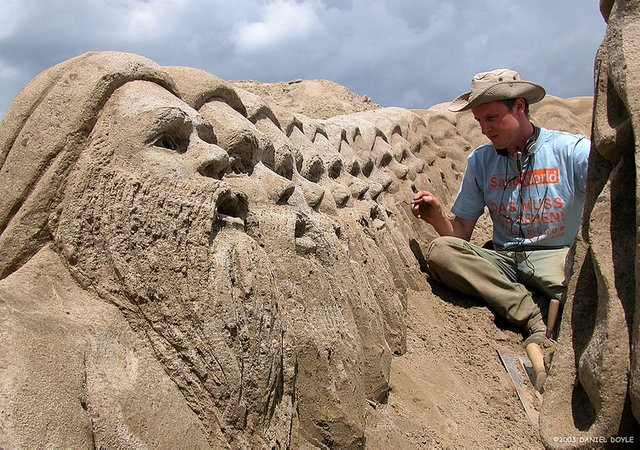
The Australian Aboriginals are an amazingly interesting race and culture. Much about them we do not know as their history was only passed down by word of mouth to those they saw worthy. So for me to say I know anything about them or their culture is a lie.
While researching this post I went down a rabbit hole trying to understand this sculpture I made along with Niall Magee and Fergus Mulvany. We were given the continent of Australia and in particular the aboriginal culture to make on this project in Travenmunde, Germany. The whole sculpture park was divided into different continents and we were given the one we knew most little about.
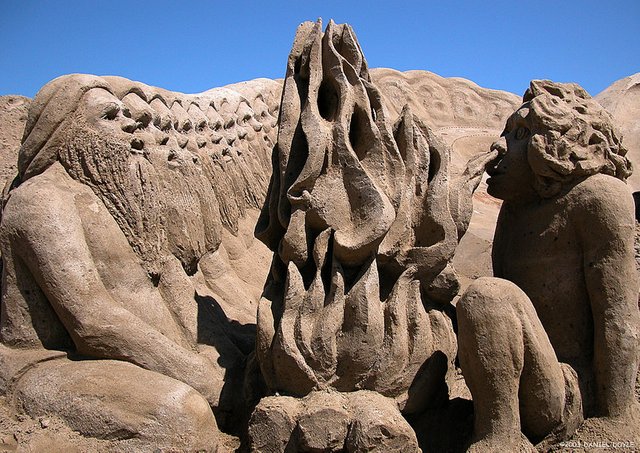
Didgerido
For the main area we wanted to go a bit trippy, tying in with the idea of dreamtime, at least as we saw it. There is some information that the Elders would smoke Pituri leaves mixed with wood ash which would send them into a Hallucinogenic state. We figured that this is how they would have entered Dreamtime. Again, this is all supposition on my part as the most I know about these things is what I learned from watching 'Crocodile Dundee' and 'Home and away' so, my apologies to all my Aboriginal readers.
In the sculpture we had two lads sitting by a fire breathing in the smoke. While one is taking his first hit the other is sailing off into Dreamtime.
I wanted to carve a special effect to represent this happening as the mind of the character drifted away, like some kind of trailbacks. The many faces become less focused as they did so.
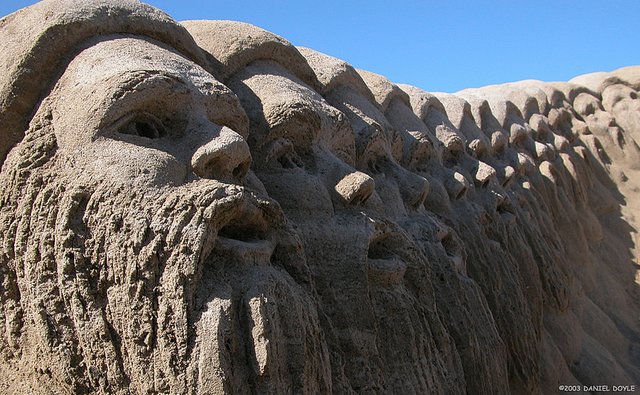
It was a fun experiment which i think really worked and would spawn a lot of ideas for other sculptures which you will see coming up in my blog. (Note to self(I like the idea of doing an out of focus sculpture, should try it more))
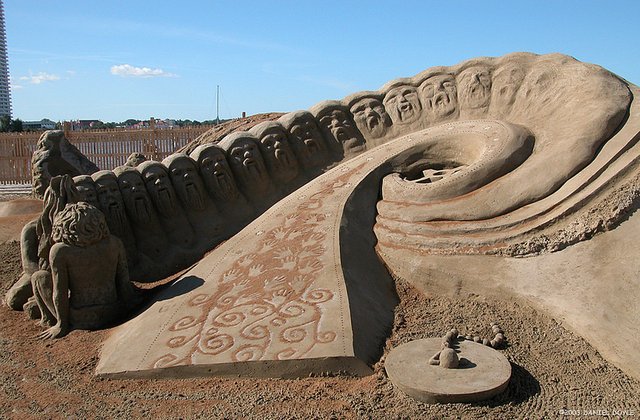
Digeridon't
The tripping guy traveled off into the background where he finally went down a plug hole going clockwise due to the Coriolis effect. (That's one for you science buffs).The plug stopper was just a fun little element to point out this fact.
We also used another coloured sand we found around the area to do some primate drawings on one surface to sell the idea that we were actually talking about Aborigines and not what we would get up to in the evenings after work.
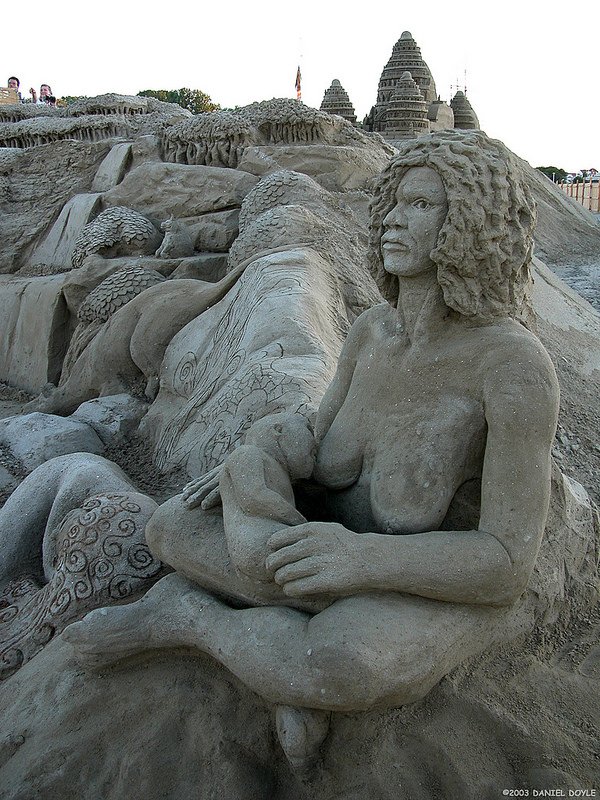
When we finished this scene we populated the areas around with various elements of people and animals. I made this breast feed woman and baby. (I hope you are not easily offended by nudity, if so grow up)
You can really see how course the sand was and in the beautiful weather we had that year it was difficult to work with it.
I some ways i really like the rough texture, I think it adds to the character of the piece.
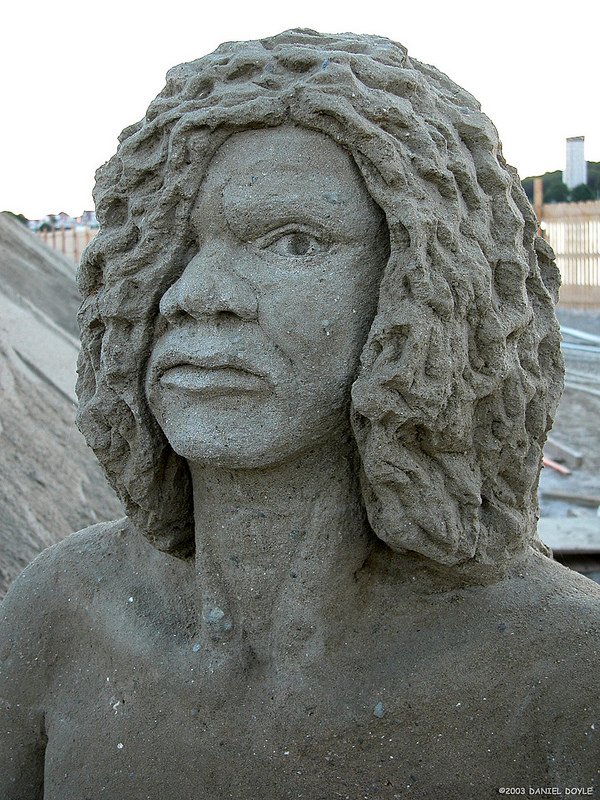
Lessons learned
Below is a very interesting conversation from the comments section of this post. I think it is important to add this info to the post.
@leoplaw 3 days ago
Having met and talked with Aboriginal people from various areas of Eastern Australia, and then from written sources, you have to keep something in mind.
There were hundreds of different nations, with different cultures and languages, just as with indigenous Americans. It is not possible to make blanket statements about cultural activities. For instance didgeridoos were only found in the far North of Australia. Didgeridoo is not even the proper name used by the people who played them.
Australia itself is larger than Europe and has extremes of climate and environment, dictating the lives of Indigenous Australians. Thus plant or animal resources were not the same over the land.
Culturally, knowledge was only passed onto those who had the right to it, through family lines or initiation, let alone it being shared with outsiders such as European settlers. This knowledge, the Law, was strictly controlled and guarded, with transgressions often being punished with spearings or death.
Dreamtime was not a psychedelic state. Dreamtime (also dream time, dream-time) is a term devised by early anthropologists to refer to a religio-cultural worldview attributed to Australian Aboriginal beliefs. The Dreaming is used to represent Aboriginal concepts of "time out of time," or "everywhen," during which the land was inhabited by ancestral figures, often of heroic proportions or with supernatural abilities. ...t has been argued that it is based on a misunderstanding or mistranslation. William Stanner remarked: "why the blackfellow thinks of 'dreaming' as the nearest equivalent in English is a puzzle".[1] Some scholars suggest that the word's meaning is closer to "eternal, uncreated."[2]
https://en.wikipedia.org/wiki/Dreamtime
Following is a link to answer to the question of Indigenous use of psychedelic substances from a person of Aboriginal descent.
@ammonite 3 days ago
Thank you for all that information, As I said this piece is from our own imaginings. I had read somewhere about the use of Pituri by some tribes and with the piece used that to form our interpretation knowing full-well it was far from the truth.
With these kind of project the process of the sculpture happens so fast you just need to make something quickly and mostly it is just fun, especially in those days. now I try to be a bit more measured in my work.
@leoplaw 2 days ago
I understand there is much misinformation and romanticising of cultures foreign to us. Similar things are done for instance to Indigenous Americans, both North and South. So, if you've had no direct contact with said people, how are you to know any better.
But having spent a little time talking with indigenous Australians, I know what a hot topic it is. Foreigners (Europeans) invaded their lands, forceably and unintentionally through disease wiped out large portions of their population. Then those who survived were removed from their lands, people, families, culture and language. You then get the more foreigners making up fanciful interpretations of the shreds left of their culture, naturally they're quite upset.
Further on the topic of the Pituri, everything I have thus read on the topic indicates that the active chemical substance is a nicotine compound. So, if ever you've smoked tobacco yourself, other than a bit of light-headedness, it has no psychoactive properties. It appears that from all available European records it was used as stimulant to help them with strenuous activities, such as long treks through the bush or desert. It is to be noted, that the particular tribes who engaged in its use were wiped out and there is no known surviving cultural knowledge. Further, as I pointed out in my previous comment, such knowledge of Pituri was for the privileged few (initiated), most notably old men. Europeans while they did note the use and effects of the plant, did not bother to ask what it meant for Aboriginal people, whether there was any sacred or spiritual aspect to it's use. So anything that you read today about their use of it is pure speculation or pure fantasy.
This quite detailed article on the topic is a tantalising glimpse of its use.
https://prehistoricdrugs.wordpress.com/2011/09/03/the-aboriginal-drug-pituri-2/
The previous link I provided, also gives a first hand perspective on the general indigenous attitudes towards traditional cultural use of psychedelics. It is to be noted, that there is a dearth of information of such use by these people, either because it was sacred and closely guarded secret that died out with the people, or as the commentator of the above link puts it, their ceremonies were "family orientated" affairs, where rhythmic dancing and singing was used to induce trance like states.
An excellent research resource of all things chemical and plant based that affect human consciousness can be found at Erowid.org.
I hope you understand, my intent is to inform and not attack you. I still love your creativity and work.
@ammonite a minute ago
Wow @leoplaw, thank you so much for taking the time to give such an in-depth explanation. I understand that this is not an attack and is something I really hoped for, to learn more about their cultures. I do feel however that me making this piece can very easily be taken as a sign of disrespect to them especially as they have faced so much at the hands of western colonisation . I assure you and all readers that this is not the case. I was just trying to learn and understand more and I don't want my work to add to their difficulties , I am happy that due to the ephemerality of sand this piece is no more and that with this post we came to talk about why it could be offensive.This is a good lesson for me to be more careful in how I research and make my sculptures, so, Thank you again.
I hope you don't mind that I add this comment thread to the main post as I think it is very valuable and adds to the documentation of the piece.


Ps
Thanks for reading. I use Steem to document my work as an ephemeral Sculptor of sand, snow and ice, among other things. This will hopefully give it a new life on the Steem blockchain. Below you will find some of my recent posts.
Thorny Vines - ice sculpture
4D Train (Remastered - sand sculpture
The black death - sand sculpture
I hope you'll join me again soon.
@ammonite
[//]:# (!steemitworldmap 53.958384 lat 10.884787 long Dreamtime -sand sculpture 2003 d3scr)
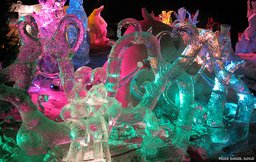
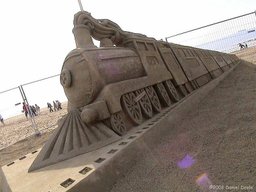
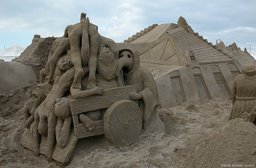
Wonderful artwork!!!!
Downvoting a post can decrease pending rewards and make it less visible. Common reasons:
Submit
Thank you.
Downvoting a post can decrease pending rewards and make it less visible. Common reasons:
Submit
:-)))
Downvoting a post can decrease pending rewards and make it less visible. Common reasons:
Submit
Ooh wow that is pretty trippy, that one with the person spinning down the drain! So did you manage to learn a bit when you got the topic you knew the least about? XD
Also had a bit of a giggle about your sorry-not-sorry with the nudity thing, I usually try to be at least a little bit sensitive to preferences but there are times when I just really want to say that XD
Downvoting a post can decrease pending rewards and make it less visible. Common reasons:
Submit
Nope, I still know very little about them or there culture.
Regarding the nudity thing. it is a topic that will come up again and again. I will warn normally in the title. But I think breast feeding and tribal nudity is less controversial.
Downvoting a post can decrease pending rewards and make it less visible. Common reasons:
Submit
I'm sure it will, there were some nsfw tussles going on last year (someone doing big downvotes because they couldn't cope with the sight of a body) which is why a bunch of us came up with the idea to do the warning system rather than using the nsfw tag (which I did use on a fairly tame piece but really wasn't worth it).
A few years before that fb and da were making the biggest deals about breastfeeding. Apparently it's obscene and pornographic while Suicide Girls ads and snatch shots are A-okay x_x I don't understand some people XD
Downvoting a post can decrease pending rewards and make it less visible. Common reasons:
Submit
I don't understand it either but will do as you suggest on some of my other posts that contain naughty bits in the future.
Downvoting a post can decrease pending rewards and make it less visible. Common reasons:
Submit
Wow, this is beautiful. I wonder how long it takes you to complete one.
Downvoting a post can decrease pending rewards and make it less visible. Common reasons:
Submit
Hi, I think it took around 6 days to make the scene, I was much slower at carving then. Thank you for the comment
Downvoting a post can decrease pending rewards and make it less visible. Common reasons:
Submit
And that means it took you up to 20 days to complete the piece.
Downvoting a post can decrease pending rewards and make it less visible. Common reasons:
Submit
A very interesting project. Did you do a scale model (in 3d or on the computer) before beginning? How long do these sculptures last?
Downvoting a post can decrease pending rewards and make it less visible. Common reasons:
Submit
No, this was all done free hand. I look on sand sculpture like the sketch itself. The fact it allows you to work so fast allows that. From looking at the materials you use i can understand that more planning would go into them. Sand sculpture can last several months to a year outside. Indoors I have known them last for years. The sand is very compact and as it dries out it turns to a soft sand stone texture. Thanks for your question.
Downvoting a post can decrease pending rewards and make it less visible. Common reasons:
Submit
Having met and talked with Aboriginal people from various areas of Eastern Australia, and then from written sources, you have to keep something in mind.
There were hundreds of different nations, with different cultures and languages, just as with indigenous Americans. It is not possible to make blanket statements about cultural activities. For instance didgeridoos were only found in the far North of Australia. Didgeridoo is not even the proper name used by the people who played them.
Australia itself is larger than Europe and has extremes of climate and environment, dictating the lives of Indigenous Australians. Thus plant or animal resources were not the same over the land.
Culturally, knowledge was only passed onto those who had the right to it, through family lines or initiation, let alone it being shared with outsiders such as European settlers. This knowledge, the Law, was strictly controlled and guarded, with transgressions often being punished with spearings or death.
Dreamtime was not a psychedelic state. Dreamtime (also dream time, dream-time) is a term devised by early anthropologists to refer to a religio-cultural worldview attributed to Australian Aboriginal beliefs. The Dreaming is used to represent Aboriginal concepts of "time out of time," or "everywhen," during which the land was inhabited by ancestral figures, often of heroic proportions or with supernatural abilities. ...t has been argued that it is based on a misunderstanding or mistranslation. William Stanner remarked: "why the blackfellow thinks of 'dreaming' as the nearest equivalent in English is a puzzle".[1] Some scholars suggest that the word's meaning is closer to "eternal, uncreated."[2]
https://en.wikipedia.org/wiki/Dreamtime
Following is a link to answer to the question of Indigenous use of psychedelic substances from a person of Aboriginal descent.
http://www.shaman-australis.com/forum/index.php?/topic/13814-use-of-psychedelics-in-australian-aborignial-cultures/&do=findComment&comment=127771
Downvoting a post can decrease pending rewards and make it less visible. Common reasons:
Submit
Dreamtime
Dreamtime (also dream time, dream-time) is a term devised by early anthropologists to refer to a religio-cultural worldview attributed to Australian Aboriginal beliefs. It was originally used by Francis Gillen, quickly adopted by his colleague Baldwin Spencer and thereafter popularised by A. P. Elkin, who, however, later revised his views. The Dreaming is used to represent Aboriginal concepts of "time out of time," or "everywhen," during which the land was inhabited by ancestral figures, often of heroic proportions or with supernatural abilities. These figures were often distinct from "gods" as they did not control the material world and were not worshipped, but only revered.
Downvoting a post can decrease pending rewards and make it less visible. Common reasons:
Submit
Thank you for all that information, As I said this piece is from our own imaginings. I had read somewhere about the use of Pituri by some tribes and with the piece used that to form our interpretation knowing full-well it was far from the truth.
With these kind of project the process of the sculpture happens so fast you just need to make something quickly and mostly it is just fun, especially in those days. now I try to be a bit more measured in my work.
Downvoting a post can decrease pending rewards and make it less visible. Common reasons:
Submit
I understand there is much misinformation and romanticising of cultures foreign to us. Similar things are done for instance to Indigenous Americans, both North and South. So, if you've had no direct contact with said people, how are you to know any better.
But having spent a little time talking with indigenous Australians, I know what a hot topic it is. Foreigners (Europeans) invaded their lands, forceably and unintentionally through disease wiped out large portions of their population. Then those who survived were removed from their lands, people, families, culture and language. You then get the more foreigners making up fanciful interpretations of the shreds left of their culture, naturally they're quite upset.
Further on the topic of the Pituri, everything I have thus read on the topic indicates that the active chemical substance is a nicotine compound. So, if ever you've smoked tobacco yourself, other than a bit of light-headedness, it has no psychoactive properties. It appears that from all available European records it was used as stimulant to help them with strenuous activities, such as long treks through the bush or desert. It is to be noted, that the particular tribes who engaged in its use were wiped out and there is no known surviving cultural knowledge. Further, as I pointed out in my previous comment, such knowledge of Pituri was for the privileged few (initiated), most notably old men. Europeans while they did note the use and effects of the plant, did not bother to ask what it meant for Aboriginal people, whether there was any sacred or spiritual aspect to it's use. So anything that you read today about their use of it is pure speculation or pure fantasy.
This quite detailed article on the topic is a tantalising glimpse of its use.
https://prehistoricdrugs.wordpress.com/2011/09/03/the-aboriginal-drug-pituri-2/
The previous link I provided, also gives a first hand perspective on the general indigenous attitudes towards traditional cultural use of psychedelics. It is to be noted, that there is a dearth of information of such use by these people, either because it was sacred and closely guarded secret that died out with the people, or as the commentator of the above link puts it, their ceremonies were "family orientated" affairs, where rhythmic dancing and singing was used to induce trance like states.
An excellent research resource of all things chemical and plant based that affect human consciousness can be found at Erowid.org.
I hope you understand, my intent is to inform and not attack you. I still love your creativity and work.
Downvoting a post can decrease pending rewards and make it less visible. Common reasons:
Submit
Wow @leoplaw, thank you so much for taking the time to give such an in-depth explanation. I understand that this is not an attack and is something I really hoped for, to learn more about their cultures. I do feel however that me making this piece can very easily be taken as a sign of disrespect to them especially as they have faced so much at the hands of western colonisation . I assure you and all readers that this is not the case. I was just trying to learn and understand more and I don't want my work to add to their difficulties , I am happy that due to the ephemerality of sand this piece is no more and that with this post we came to talk about why it could be offensive.This is a good lesson for me to be more careful in how I research and make my sculptures, so, Thank you again.
I hope you don't mind that I add this comment thread to the main post as I think it is very valuable and adds to the documentation of the piece.
Downvoting a post can decrease pending rewards and make it less visible. Common reasons:
Submit
Sure. But remember, I'm just a whitey repeating what I've been told, directly and indirectly, along with what I've read. The original source is always best.
Oh, something I did't include in my rant, and I don't know if you picked it up in any of the links I gave you, the plant, Pituri, was not smoked, but combined with ash and chewed. This gum was stuck behind the ear to always have it on hand. Socially, they (the old men, the elders) would then pass it around and chew it until it was returned to the owner who would stick it behind his ear again. So it was kind of like chewing tobacco and a nicotine patch. Sometimes, fact is stranger than fiction. ;-)
Downvoting a post can decrease pending rewards and make it less visible. Common reasons:
Submit
This is amazing, @ammonite <3 Love the design so much! And the detailing of each sculpted forms are wonderfully done <3 Gorgeous works <3 <3 <3
Downvoting a post can decrease pending rewards and make it less visible. Common reasons:
Submit
Thank you @veryspider (cool name by the way) It was a fun piece to play with and the style was something i played with more over the years.
Downvoting a post can decrease pending rewards and make it less visible. Common reasons:
Submit
this is fantastic, and a great subject!
upvoted, resteemed and shared:
https://twitter.com/visionaryartcom/status/1051229110100480002
Downvoting a post can decrease pending rewards and make it less visible. Common reasons:
Submit
Thank you @thermoplastic for sharing my post. It was a fun project even thoughwith the subject we took some liberties.
Downvoting a post can decrease pending rewards and make it less visible. Common reasons:
Submit
Dear Artist @ammonite ! This post has been resteemed and upvoted from FineArtNow community account. Follow us for more support. The Idea of this blog is to bring creative people and art enthusiasts together and to increase the reach of Steemit - Artists ! See you soon !
Downvoting a post can decrease pending rewards and make it less visible. Common reasons:
Submit
Congratulations, Your Post Has Been Added To The Steemit Worldmap!
Author link: http://steemitworldmap.com?author=ammonite
Post link: http://steemitworldmap.com?post=dreamtime-sand-sculpture
Want to have your post on the map too?
Downvoting a post can decrease pending rewards and make it less visible. Common reasons:
Submit
Hello @ammonite, thank you for sharing this creative work! We just stopped by to say that you've been upvoted by the @creativecrypto magazine. The Creative Crypto is all about art on the blockchain and learning from creatives like you. Looking forward to crossing paths again soon. Steem on!
Downvoting a post can decrease pending rewards and make it less visible. Common reasons:
Submit
Hi @ammonite!
Your post was upvoted by @steem-ua, new Steem dApp, using UserAuthority for algorithmic post curation!
Your UA account score is currently 4.198 which ranks you at #2818 across all Steem accounts.
Your rank has improved 5 places in the last three days (old rank 2823).
In our last Algorithmic Curation Round, consisting of 516 contributions, your post is ranked at #81.
Evaluation of your UA score:
Feel free to join our @steem-ua Discord server
Downvoting a post can decrease pending rewards and make it less visible. Common reasons:
Submit